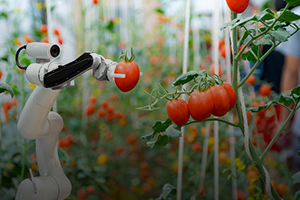Robotic Farming

While larger tractor manufacturers continue their long-term plans toward totally autonomous farming equipment, developers of smaller, specialized robots are already “making hay” on farms around the world.
For example, in Australia, farmers are beginning to reap the benefits of replacing 120-foot-wide, 16-ton spraying machines with smaller, truck-sized robots to control weeds. Instead of bathing a field in chemicals, the robots are capable of directing the weed killer more precisely at the weeds. One farmer saved 80 percent on chemical costs, improved crop yields, and was able to reduce the environmental impact of farm runoff in the process.
In Canada, another manufacturer has created an autonomous power platform that can be paired with a variety of implements (including a seeder, sprayer, land roller, and grain cart). The system is guided by preloaded field maps and GPS sensors to cover the same amount of land as a traditional combine. The use of a single power platform for multiple tasks reduces maintenance as well as labor costs.
There is little doubt that robots are going to transform the way we grow food through greater efficiency and lower costs. Smaller equipment may also prove to be better for the soil itself by alleviating compaction, a factor that could also increase yields by an estimated 7 percent in some cases.
For information: SwarmFarm; Web site: http://www.swarmfarm.com/ DOT Technology Corp.; Web site: https://seedotrun.com/